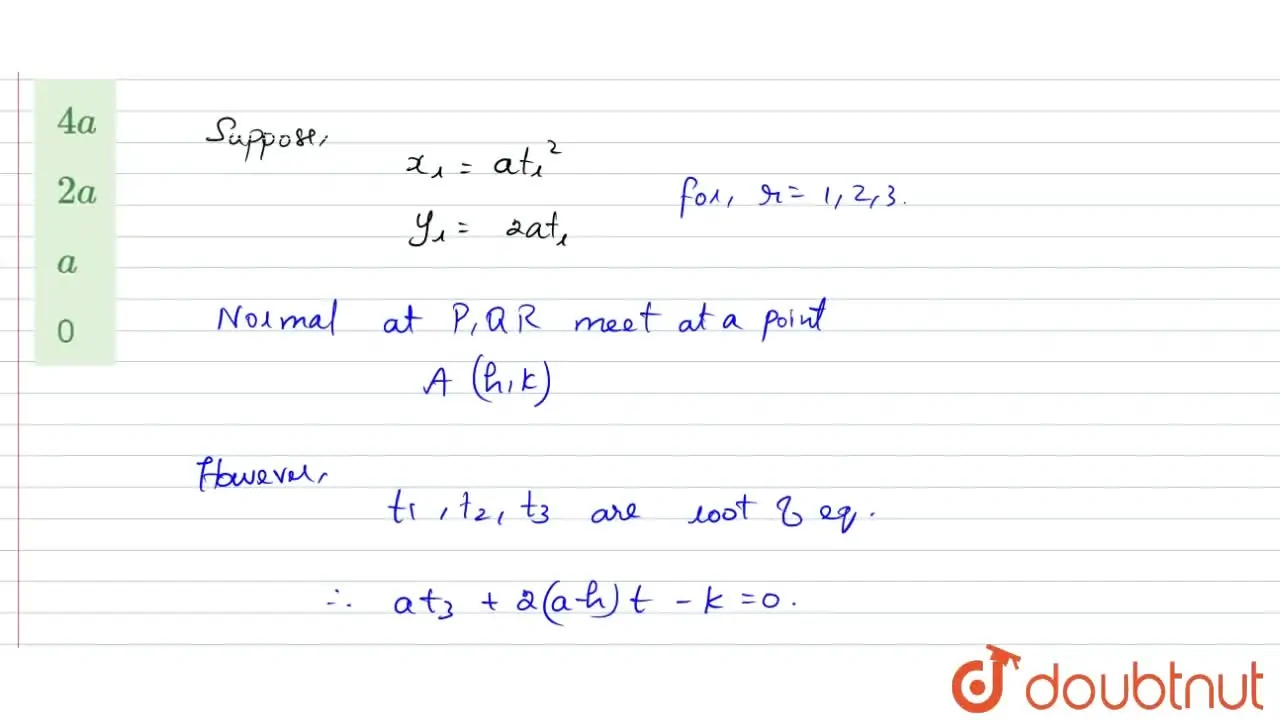If (x1,y1),(x2,y2) and (x3,y3) are the feet of the three normals drawn from a point to the parabola y2=4ax, then x1−x2y3+x2−x3y1+x3−x1y2 is equal to
4a
2a
a
0
The correct Answer is:D
Step by step video & image solution for If (x_1,y_1),(x_2,y_2)" and "(x_3,y_3) are the feet of the three normals drawn from a point to the parabola y^2=4ax, then (x_1-x_2)/(y_3)+(x_2-x_3)/(y_1)+(x_3-x_1)/(y_2) is equal to by Maths experts to help you in doubts & scoring excellent marks in Class 12 exams.
Related Playlists
- BOOK - VMC MODULES ENGLISHCHAPTER - CONIC SECTIONSEXERCISE - Numerical Value Type for JEE Main15videos
CONIC SECTIONS
- BOOK - VMC MODULES ENGLISHCHAPTER - CONIC SECTIONSEXERCISE - JEE MAIN ARCHIVE15videos
CONIC SECTIONS
- BOOK - VMC MODULES ENGLISHCHAPTER - CONIC SECTIONSEXERCISE - LEVEL - 1178videos
CONIC SECTIONS
- BOOK - VMC MODULES ENGLISHCHAPTER - COMPLEX NUMBERS EXERCISE - JEE ARCHIVE76videos
COMPLEX NUMBERS
- BOOK - VMC MODULES ENGLISHCHAPTER - DIFFERENTIAL CALCULUSEXERCISE - JEE Advanced (Archive)75videos
DIFFERENTIAL CALCULUS
Similar Questions
If P(x1,y1),Q(x2,y2) and R(x3,y3) are three points on y2=4ax and the normal at PQ and R meet at a point, then the value of x1−x2y3+x2−x3y1+x3−x1y2=
View SolutionIf t1,t2,t3 are the feet of normals drawn from (x1,y1) to the parabola y2=4ax then the value of t1t2t3 =
View SolutionIf (x1,y1) and (x2,y2) are the ends of a focal chord of the parabola y2 = 4ax then show that x1x2=a2,y1y2=−4a2
View SolutionFind the equation of tangents drawn to the parabola y=x2−3x+2 from the point (1,−1).
View SolutionFind the equation of tangents drawn to the parabola y=x2−3x+2 from the point (1,−1).
View SolutionIf A(x1,y1),B(x2,y2)andC(x3,y3) are vertices of an equilateral triangle whose each side is equal to a, then prove that
∣∣ ∣ ∣∣x1y12x2y22x3y32∣∣ ∣ ∣∣ is equal toView SolutionIf A(x1,y1),B(x2,y2)andC(x3,y3) are vertices of an equilateral triangle whose each side is equal to a , then prove that ∣∣ ∣ ∣∣x1y12x2y22x3y32∣∣ ∣ ∣∣2=3a4
View SolutionIf A(x1,y1),B(x2,y2) and C(x3,y3) are vertices of an equilateral triangle whose each side is equal to a , then prove that ∣∣ ∣ ∣∣x1y12x2y22x3y32∣∣ ∣ ∣∣2=3a4
View SolutionShow that the equation of the chord of the parabola y2=4ax through the points (x1,y1)and(x2,y2) on it is : (y−y1)(y−y2)=y2−4ax
View SolutionIf A(x1,y1),B(x2,y2),C(x3,y3) are the vertices of a ΔABCand(x,y) be a point on the median through A. Show that : ∣∣ ∣ ∣∣xy1x1y11x2y21∣∣ ∣ ∣∣+∣∣ ∣ ∣∣xy1x1y11x3y31∣∣ ∣ ∣∣=0
View Solution


